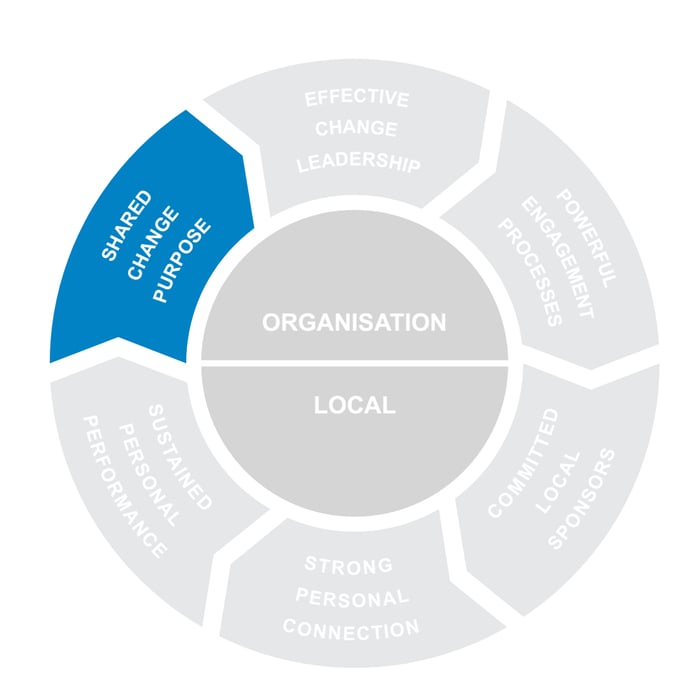
Driving successful change means balancing the local and organizational factors. Ensuring that the right change elements are focused on by local leaders, while also ensuring the overall organizational elements are in place to ensure consistent, meaningful change across the company. Over the next three weeks we will be looking in more detail at the organizational change factors.
The elements of successful change
Last week we introduced the 6 critical success factors for change. Three success factors sit at the organizational level; three factors sit at the local level. Starting from the top, let’s look a bit more into CSF1, and identifying the hurdles you may face in achieving it during your change project.
Critical Success Factor 1: Shared Change Purpose
Articulating, communicating and maintaining a shared purpose helps create urgency, energy and unity. It is the critical first step at the launch of an initiative, but also directs people’s focus and maintains their resolve and motivation as they work towards achieving and sustaining the change benefits.
The change purpose needs to convey to the organization the reason for the change, the urgency of the change, the imperative, and provide a vision of what the future looks like.
This clear statement of intent and purpose is necessary for building commitment and reducing the confusion that often generates demand for unnecessary change. It helps people to deal with some of the personal disruption they need to overcome before embracing the change.
Creating, communicating and maintaining a clear change purpose will take effort
Creating, communicating and enforcing a shared change purpose is not as easy as writing a vision statement for the change project. The change purpose needs to be almost tangible, something that people across the organization can hold onto in turbulent times and which will help guide decisions made during the implementation of the change.
Some of the common hurdles change leaders face in achieving and maintain a shared change purpose include:
- The change purpose is not communicated from the top: the statement of change needs to be driven and communicated from the top. This purpose reflects the senior leadership view, and intent, behind the change. If the communication starts from the project office then it is a little bit like “he/she said”… you are not providing the organization credibility of what is communicated. People need to feel a sense of confidence that there is commitment to provide the necessary support from the highest levels in the organization.
- The change purpose does not create a sense of urgency: Without urgency, particularly at the start, major changes can become stalled or fail to gain traction in the organization. The future painted in the change purpose may look enticing, but unless there is a strong reason, an imperative, for people to change (and change now) then most individuals fall back into their comfort zone. You need to ensure that there is energy and urgency to move people from their comfort zone into the future state.
- The senior leadership team does not speak with one voice: This is a common one which we are sure many of you have witnessed at one time or another. While the official communication states one thing, individual leaders share their own views on the change potentially leading to pockets of resistance, or a misaligned implementation of the change.
- The senior leadership team does not act in cohesion: similar to the point above, leadership actions and behaviors need to mirror what is communicated. Seeing and hearing different messages creates mistrust across the organization, and can quickly derail any change initiatives. While it may be hard to get 100% alignment across the organization, it is important to have a majority of influencers on board.
- The change purpose is not cascaded down through the organization: The shared change purpose needs to be consumable across the organization. Local managers need to take the organizational change purpose and communicate it through their area of responsibility in a way which their teams can relate to, while still maintain that direct link to the organizational wide communication. Without this, the change purpose may remain at too abstract a level for some teams.
- The change purpose does not create a picture of the future: It is sometimes hard to paint a clear picture of the future, as we are all often working in some degree of ambiguity. But the direction the change is taking the organization to, linked to the imperative for change, needs to be clear enough, right from the beginning, so that people can grasp onto and believe it.
- The change purpose loses focus over time: Too often a change purpose is communicated strongly at the beginning of a change project, and then is not referenced at all in later stages, or it is completely disregarded. The change purpose needs to be maintained throughout the period of change and into the business-as-usual state. In fact, the change purpose should become stronger as time goes on and give more clarity to the details of the future state.
There is a key role running across these items: the critical role of the change agent who should be acting as the moderator and coach. Identifying where key messages are not in alignment with the change purpose, where leadership actions and words are not in sync, and ensuring that the change purpose is packaged in a way that can be easily cascaded down through the organization.
Change leaders need to ensure that the change purpose is communicated, and communicated well (not just in an email!), and the communication and alignment is maintained throughout the change.
Interested to learn more; read how the Critical Success Factors of change are incorporated into our change management methodology. Or read about further cases and real-life examples in our book, Successful Change.



Leave a comment